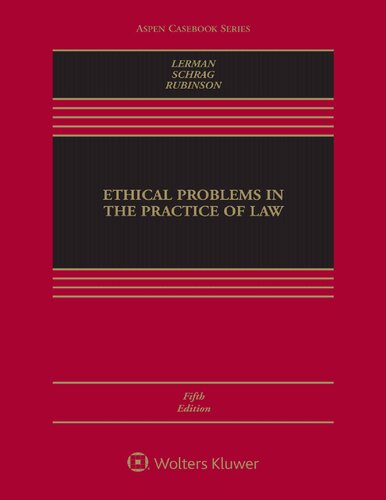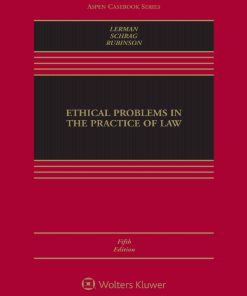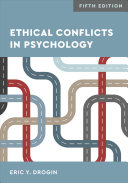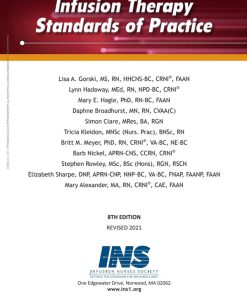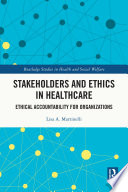Ethical Problems in the Practice of Law 5th Edition by Lisa G. Lerman 9781543846225 154384622X
$50.00 Original price was: $50.00.$25.00Current price is: $25.00.
Ethical Problems in the Practice of Law 5th Edition Lisa G. Lerman – Ebook Instant Download/Delivery ISBN(s): 9781543846225, 154384622X
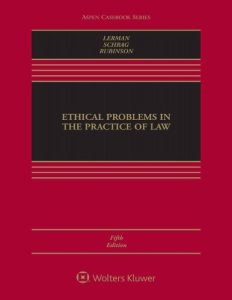
Product details:
- ISBN 10:154384622X
- ISBN 13:9781543846225
- Author: Lisa G. Lerman
Ethical Problems in the Practice of Law
Table contents:
A. Ethics, morals, and professionalism
B. Some central themes in this book
1. Conflicts of interest
2. Truthfulness
3. Lawyers’ duties to clients versus their duties to the justice system
4. Lawyers’ personal and professional interests versus their ethical and fiduciary obligations
5. Self-interest as a theme in regulation of lawyers
6. Lawyers as employees: Institutional pressures on ethical judgments
7. The changing legal profession
C. The structure of this book
D. The rules quoted in this book: A note on sources
E. Stylistic decisions
Chapter 1: The Legal Profession: Bar Admission, History, and Diversity
A. Admission to the bar
1. Changes in bar admission requirements over time
2. Contemporary bar admission requirements
3. The bar examination
4. The character and fitness inquiry
a. Criteria for evaluation
b. Filling out the character questionnaire
Problem 1-1: Adderall
c. Mental health questions about applicants
d. Law school discipline: A preliminary screening process
Problem 1-2: The Doctored Resume
B. History and development of the U.S. legal profession
1. Pre-revolutionary America
2. The nineteenth and twentieth centuries
3. History of American legal education
C. Diversity and discrimination in the legal profession
1. Women lawyers
2. Lawyers of color
3. Lesbian, gay, bisexual, transgender, and queer lawyers
4. Lawyers with disabilities
5. Lawyers from low-income families
6. Other bases of discrimination in the legal profession
Chapter 2: The Legal Profession: Regulation, Discipline, and Liability
A. Institutions that regulate lawyers
1. The highest state courts
2. State and local bar associations
3. Lawyer disciplinary agencies
4. American Bar Association
5. American Law Institute
6. Federal and state courts
7. Legislatures
8. Administrative agencies
9. Prosecutors
10. Malpractice insurers
11. Law firms and other employers
12. Clients
B. State ethics codes
C. The disciplinary system
1. Grounds for discipline
Problem 2-1: The Dying Mother
2. Reporting misconduct by other lawyers
a. The duty to report misconduct
Problem 2-2: Exculpatory Evidence
b. Lawyers’ responsibility for ethical misconduct by others in a law office
Problem 2-3: The Little Hearing
c. Legal protections for subordinate lawyers
The Wieder case
D. Civil liability
1. Legal malpractice
2. Malpractice insurance
3. Other civil liability
a. Liability for breach of contract
b. Liability for violation of regulatory statutes
4. Disqualification for conflicts of interest
E. Criminal liability
F. Client protection funds
Chapter 3: Relationships Between Lawyers and Clients
A. Formation of the lawyer-client relationship
1. Lawyer discretion in selection of clients
2. Offering advice as the basis for a lawyer-client relationship
Togstad v. Vesely, Otto, Miller & Keefe
B. Lawyers’ duties of competence, diligence, honesty, and communication
1. Competence
Problem 3-1: The Washing Machine
2. Competence in criminal cases
a. Strickland v. Washington
b. The aftermath of Strickland
Missouri v. Frye
Lafler v. Cooper
Problem 3-2: A Desire to Investigate
3. Diligence
4. Candor and communication
a. Is it ever okay to lie?
b. Lying versus deception: Is there a moral distinction?
c. Honest mistakes
d. Honesty and communication under the ethics rules
e. Civil liability for dishonesty to clients
5. Candor in counseling
Problem 3-3: Torture
6. Duties imposed by contract in addition to those imposed by the ethics codes
7. Agreements to limit the scope of representation
8. Contractual modification of a lawyer’s duties: Collaborative law practice
C. Lawyers’ responsibilities as agents
1. Express and implied authority
2. Apparent authority
3. Authority to settle litigation
D. Who calls the shots?
1. The competent adult client
Jones v. Barnes
2. Clients with diminished capacity
a. Assessing diminished capacity
b. Options available to attorneys when clients have diminished capacity
Problem 3-4: Vinyl Windows
c. Juveniles
E. Terminating a lawyer-client relationship
1. Duties to the client at the end of the relationship
2. Grounds for termination before the work is completed
a. When continued representation would involve illegal or unethical conduct
b. If the lawyer becomes impaired
c. When the client fires the lawyer
d. When the lawyer wants to terminate the relationship
e. Matters in litigation
f. When the client stops paying the fee
g. When the case imposes an unreasonable financial burden on the lawyer
h. When the client will not cooperate
3. Collection of fees
Chapter 4: The Duty to Protect Client Confidences
A. The basic principle of confidentiality
1. What is confidential?
Problem 4-1: Your Dinner with Anna
2. Protection of information if there is a reasonable prospect of harm to a client’s interests
3. The bottom line on informal communications
4. Additional cautions about protecting client confidences
5. Confidentiality and technology
B. Exceptions to the duty to protect confidences
1. Informed consent and implied authorization
2. Revelation of past criminal conduct
Case study: The defense of Robert Garrow
Problem 4-2: The Buried Bodies, Scene 1
Problem 4-3: The Buried Bodies, Scene 2
What happened next
The Belge case
People v. Belge
People v. Belge (appeal)
Problem 4-4: The Buried Bodies, Scene 3
3. The risk of future injury or death
Spaulding v. Zimmerman
Spaulding v. Zimmerman (appeal)
Problem 4-5: Rat Poison
4. Client frauds and crimes that cause financial harm
a. Ethics rules allowing revelation of client crimes or frauds to prevent, mitigate, or remedy harm to others
b. Enron, the Sarbanes-Oxley Act, and Rules 1.6(b)(2) and (3)
c. Subsequent developments in the implementation of Sarbanes-Oxley
Problem 4-6: Reese’s Leases
5. Revealing confidences to obtain advice about legal ethics
6. Using a client’s confidential information to protect the lawyer’s interests
7. Revealing confidences to comply with a court order or other law
8. Revealing confidences to prevent certain conflicts of interest
C. Use or disclosure of confidential information for personal gain or to benefit another client
Problem 4-7: An Investment Project
D. Talking to clients about confidentiality
Chapter 5: The Attorney-Client Privilege and the Work Product Doctrine
A. Confidentiality and attorney-client privilege compared
1. Source of the privilege
2. Scope of the privilege
3. Methods of enforcing the privilege
B. The elements of attorney-client privilege
1. Communication
2. Privileged persons
3. Communication in confidence
4. Communication for the purpose of seeking legal assistance
C. Asserting the privilege
D. Waiver of the privilege
E. Exceptions to the privilege
1. The Sixth Amendment
2. Lawyer self-defense
3. Other revelations permitted or required by the ethics codes
Problem 5-1: Murder for Hire
4. The crime-fraud exception
Problem 5-2: The Payoff
F. The death of the client
1. Introduction
Problem 5-3: A Secret Confession
2. The suicide of Vincent Foster
a. Factual background
b. The Supreme Court evaluates the privilege claim
Swidler & Berlin v. United States
G. The attorney-client privilege for corporations
H. The attorney-client privilege for government officials
I. The work product doctrine
Problem 5-4: Worldwide Bribery
Chapter 6: Conflicts of Interest: Current Clients
A. An introduction to conflicts of interest
1. What makes the study of conflicts difficult
2. How the conflicts chapters are organized
3. How the conflicts rules are organized
B. General principles in evaluating concurrent conflicts
1. Direct adversity
2. Material limitation
3. Nonconsentable conflicts
a. The lawyer’s reasonable belief
b. Representation prohibited by law
c. Suing one client on behalf of another client
4. Informed consent
5. Withdrawal and disqualification
Problem 6-1: The Injured Passengers, Scene 1
6. Imputation of concurrent conflicts
Problem 6-2: Food Poisoning
C. Conflicts between current clients in litigation
1. Suing a current client
Problem 6-3: I Thought You Were My Lawyer!
2. Cross-examining a current client
3. Representation of co-plaintiffs or co-defendants in civil litigation
Problem 6-4: The Injured Passengers, Scene 2
4. Representing economic competitors in unrelated matters
5. Positional conflicts: Taking inconsistent legal positions in litigation
Problem 6-5: Top Gun
Chapter 7: Conflicts Involving Former and Prospective Clients
A. Nature of conflicts between present and former clients
B. Duties to former clients
C. Distinguishing present and former clients
Problem 7-1: Keeping in Touch
Problem 7-2: A Better Client
D. Evaluating successive conflicts
1. The same matter
2. Substantial relationship
3. Material adversity
E. Addressing former client conflicts in practice
F. Conflicts between the interests of a present client and a client who was represented by a lawyer’s former firm
1. Analyzing former firm conflicts
2. Using or revealing a former client’s confidences
G. Imputation of former client conflicts to affiliated lawyers
Problem 7-3: The Bid Protest
Problem 7-4: A Brief Consultation
Problem 7-5: The Fatal Shot
H. Conflicts involving prospective clients
Problem 7-6: The Secret Affair
Chapter 8: Conflicts Issues in Particular Practice Settings
A. Representing multiple parties who are not in litigation
B. Representing organizations
1. Who is the client?
Problem 8-1: My Client’s Subsidiary
2. Representing the entity and employees
3. Duty to protect confidences of employees
4. Responding to unlawful conduct by corporate officers and other employees
5. Entity lawyers on boards of directors
Problem 8-2: “Don’t Rock the Boat”
C. Representing co-defendants in criminal cases
1. Costs and benefits of joint representation of co-defendants
2. Conflicts issues and Sixth Amendment concerns in criminal defense
Problem 8-3: Police Brutality, Scene 1
Problem 8-4: Police Brutality, Scene 2
Problem 8-5: Police Brutality, Scene 3
D. Representing co-defendants in civil cases
E. Representing family members
1. Representing both spouses in a divorce
2. Representing family members in estate planning
Florida Bar Opinion 95-4 (1997)
Problem 8-6: Representing the McCarthys
F. Representing insurance companies and insured persons
G. Representing employers and immigrant employees
H. Representing plaintiffs in class actions
I. Representing parties to aggregate settlements of individual cases
Chapter 9: Conflicts of Interest Between Lawyers and Clients
A. Legal fees
1. Lawyer-client fee contracts
a. Types of fee agreements
b. Reasonable fees
Matter of Fordham: When a fee may be considered excessive
c. Communication about fee arrangements
Problem 9-1: An Unreasonable Fee?
d. Modification of fee agreements
Problem 9-2: Rising Prices
2. Regulation of hourly billing and billing for expenses
Patrick J. Schiltz, On Being a Happy, Healthy, and Ethical Member of an Unhappy, Unhealthy, and Unethical Profession
Billing irregularities: A case study
Lisa G. Lerman, Scenes from a Law Firm
3. Contingent fees
a. In general
b. Criminal and domestic relations cases
4. Forbidden and restricted fee and expense arrangements
a. Buying legal claims
b. Financial assistance to a client
Problem 9-3: An Impoverished Client
c. Publication rights
d. Advance payment of fees and nonrefundable retainer fees
5. Fee disputes
a. Prospective limitations of lawyers’ liability and settlement of claims against lawyers
b. Fee arbitration
c. Collection of fees
d. Fees owed to a lawyer who withdraws or is fired before the matter is completed
6. Dividing fees with other firms or with nonlawyers
a. Division of fees between lawyers not in the same firm
b. Sharing fees with nonlawyers
7. Payment of fees by a third party
B. Lawyer as custodian of client property and documents
1. Client trust accounts
2. Responsibility for client property
a. Prompt delivery of funds or property
b. Disputes about money or property in lawyer’s possession
c. Lawyers’ responsibilities to clients’ creditors
3. Administering estates and trusts
C. Conflicts with lawyers’ personal or business interests
1. In general
2. Business transactions between lawyer and client
3. Gifts from clients
4. Sexual relationships with clients
5. Intimate or family relationships with adverse lawyers
6. Imputation of lawyer-client conflicts to other lawyers in a firm
Chapter 10: Conflicts Issues for Government Lawyers and Judges
A. Regulation of government lawyers and those who lobby them
1. The law governing lobbying: An introduction
2. Conflict of interest and “revolving door” statutes
B. Successive conflicts of former and present government lawyers
1. Conflicts of former government lawyers in private practice
a. What is a “matter”?
b. Personal and substantial participation
c. Screening of former government lawyers
d. Confidential government information
2. Conflicts of government lawyers who formerly worked outside of government
Problem 10-1: The District Attorney
3. Conflicts of private lawyers who currently represent government agencies
C. Conflicts involving judges, law clerks, arbitrators, and mediators
1. History of judicial ethics codes in the United States
2. Overview of the Model Code of Judicial Conduct
3. Impartiality and fairness; avoidance of bias, prejudice, and harassment
4. Ex parte communications and communications by a judge with third parties
5. Disqualification of judges
Problem 10-2: The Judge’s Former Professor
6. Conflicts rules for former judges, law clerks, arbitrators, and mediators
a. Personal and substantial participation
b. Imputation
c. Employment negotiation
7. Conflicts rules for lawyers currently acting as third party neutrals
Chapter 11: Lawyers’ Duties to Courts
A. Being a good person in an adversary system
Stephen Gillers, Can a Good Lawyer Be a Bad Person?
B. Investigation before filing a complaint
Problem 11-1: Your Visit from Paula Jones
C. Truth and falsity in litigation
1. The rules on candor to tribunals
2. Which rule applies when? A taxonomy of truth-telling problems in litigation
3. A lawyer’s duties if a client or witness intends to give false or misleading testimony
a. When the lawyer knows that a criminal defendant intends to lie on the stand
Nix v. Whiteside: No Sixth Amendment right to testify falsely
b. The lawyer’s obligations under Rule 3.3 in civil and criminal matters
Problem 11-2: Flight from Sudan, Scene 1
c. A lawyer’s duties if a client intends to mislead the court without lying
Problem 11-3: Flight from Sudan, Scene 2
d. A lawyer’s duties if he knows that a client has lied to a tribunal
e. Variations in state rules on candor to tribunals
4. False impressions created by lawyers during litigation
How Simpson Lawyers Bamboozled a Jury
Problem 11-4: The Drug Test
Problem 11-5: The Body Double
5. Lawyers’ duties of truthfulness in preparing witnesses to provide evidence
D. Concealment of physical evidence and documents
1. Duties of criminal defense lawyers with respect to evidence of crimes
Problem 11-6: Child Pornography
2. Concealment of documents and other evidence in civil and criminal cases
a. A limited obligation to reveal
b. A lawyer’s duties in responding to discovery requests
Ethics: Beyond the Rules
Problem 11-7: The Damaging Documents
E. The duty to disclose adverse legal authority
F. Disclosures in ex parte proceedings
G. Improper influences on judges and juries
1. Improper influences on judges
a. Ex parte communication with judges
b. Campaign contributions
2. Improper influences on juries
a. Lawyers’ comments to the press
Narrowing restrictions on trial publicity: The Gentile case
Scott Brede, A Notable Case of Exceptionally Unsafe Sex
b. Impeachment of truthful witnesses
Harry I. Subin, The Criminal Defense Lawyer’s “Different Mission”: Reflections on the “Right” to Present a False Case
c. Statements by lawyers during jury trials
H. Agreements not to accept future cases
I. Lawyers’ duties in nonadjudicative proceedings
Chapter 12: Lawyers’ Duties to Adversaries and Third Persons
A. Communications with lawyers and third persons
1. Deception of third persons
a. The duty to avoid material false statements
Problem 12-1: Emergency Food Stamps
b. Lawyers’ duties of truthfulness in fact investigation
The Beatles Club case
Problem 12-2: Insurance Claims
c. Lawyers’ duties of truthfulness in negotiation
d. Lawyers’ duties upon receipt of inadvertently transmitted information, including metadata
2. Restrictions on contact with represented persons
a. Contacts in person or by telephone
The Messing case
The Cronin case
b. The use of social media to investigate adverse persons and others
3. Restrictions on contact with unrepresented persons
Problem 12-3: The Complaining Witness
4. Respect for the rights of third persons
Problem 12-4: The Break-In
Note: Stolen documents as evidence
B. Duties of prosecutors
Ken Armstrong & Maurice Possley, Trial and Error, Part 1: Verdict: Dishonor
1. Undercover investigations
Problem 12-5: The Prosecutor’s Masquerade
2. The basis for charging a suspect
3. A prosecutor’s duty to reveal exculpatory evidence
The Duke lacrosse case
4. A prosecutor’s duty with respect to unreliable evidence
5. A prosecutor’s duty to avoid improper pretrial publicity
6. Enforcement of ethical rules against prosecutors
Ellen Yaroshefsky, Wrongful Convictions: It Is Time to Take Prosecution Discipline Seriously
C. Conduct prejudicial to the administration of justice
Problem 12-6: A Letter of Commendation
D. Are lawyers really too zealous?
Ted Schneyer, Moral Philosophy’s Standard Misconception of Legal Ethics
Chapter 13: The Changing Landscape of Law Practice
A. Unauthorized practice of law: Who can provide legal services
1. Prohibition of unauthorized practice of law by nonlawyers
Problem 13-1: Special Education
2. Restrictions on multistate practice by lawyers
3. Programs allowing nonlawyers to provide some legal assistance
a. Limited license legal technicians
b. Courthouse navigators
c. Legal document assistants
4. New providers of legal services
B. Getting business: Advertising and solicitation
1. Advertising of legal services
Bates v. State Bar of Arizona
2. Solicitation of clients
Problem 13-2: Traffic Crimes
C. Multidisciplinary practice
D. Financing law practice
1. Litigation finance: Nonlawyer funding of lawsuits
2. Nonlawyer ownership of and investment in law firms
E. Temporary and contract lawyers
F. Outsourcing legal work to cut labor costs: Offshoring and onshoring
G. Globalization of law practice
Chapter 14: Access to Justice: The Lawyer’s Role
A. The unmet need for legal services
B. Sources of free legal services for those who cannot afford legal fees
1. Right to counsel for indigent litigants
a. Criminal defendants
b. Parties in civil and administrative proceedings
2. Civil legal aid
a. Legal Services Corporation
Problem 14-1: Restrictions on Legal Services
b. Other civil legal services
c. Supporting legal services for indigent people with interest on trust accounts
3. Fee-shifting statutes
a. Fee waiver as a term of a settlement: Evans v. Jeff D
b. Who is a “prevailing party” entitled to attorneys’ fees?
4. Conflicts in public interest litigation
Problem 14-2: The Prisoners’ Dilemma
C. Pro bono representation
Problem 14-3: Mandatory Pro Bono Service
D. Loan forgiveness and scholarships for public service lawyers
E. A concluding problem
Problem 14-4: The Future of the Legal Profession
About the Authors
People also search:
ethical problems in the practice of law
ethical problems in the practice of law 6th edition pdf
ethical problems in the practice of law pdf
ethical problems in the practice of law 5th edition
ethical problems in the practice of law by lerman
You may also like…
Politics & Philosophy - Anthropology
Ethical and Aesthetic Explorations of Systemic Practice 1st Edition Pietro Barbetta
Mathematics - Discrete Mathematics
The Elements of Advanced Mathematics 5th Edition by Steven G. Krantz 9781000593310 1000593312
Computers - Computer Certification & Training
CEH Certified Ethical Hacker Practice Exams, 5th Edition Matt Walker
Biology and other natural sciences - Biology
Infusion Therapy Standards of Practice 8th Edition by Lisa A. Gorski
Business & Economics - Management & Leadership
Computers - Internet & World Wide Web
CEH Certified Ethical Hacker All-in-One Exam Guide, 5th Edition Walker

